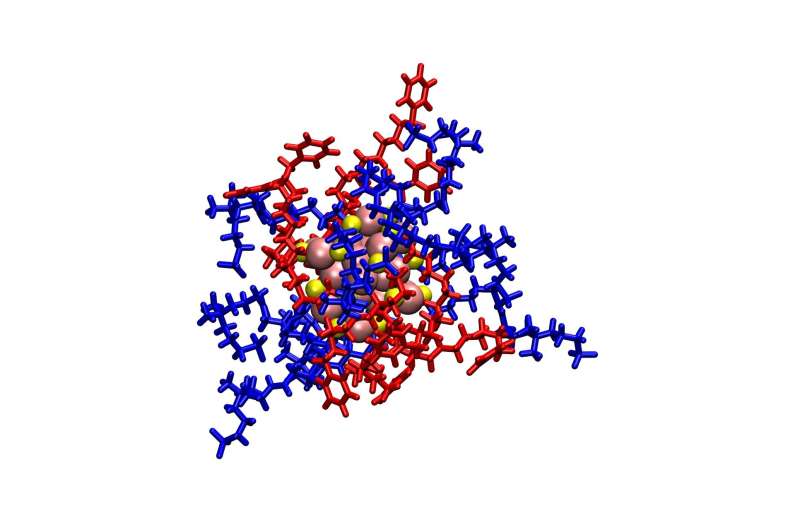POSTMODERN ALCHEMY
Going for gold to reduce antibiotic resistance

Tiny particles of gold could be the new weapon in the fight against bacterial antibiotic resistance, according to research just published.
Scientists have been investigating the use of gold nanoclusters—each made up of about 25 atoms of gold—to target and disrupt bacterial cells, making them more susceptible to standard antibiotic treatments.
A report from the World Health Organization last year said, "Antibiotic resistance is rising to dangerously high levels in all parts of the world," and called for greater investment in ways to tackle the problem.
For several years, researchers have recognized the antimicrobial properties of specially-adapted gold nanoparticles, but they have struggled to find a way of getting the nanoparticles to the site of a bacterial infection without harming healthy host mammalian cells.
Now a study by an international team of scientists from the University of Leeds, Southern University of Science and Technology in Shenzhen and Fudan University, Shanghai, both in China, has identified a way of packaging the gold nanoclusters in a molecular envelope that makes them less toxic to healthy tissue without affecting their antibacterial properties.
Laboratory studies have shown that the approach has had a "strong effect" in terms of killing a range of bacteria, some linked to hospital acquired infections and resistant to standard antibiotic treatments.
The findings, which are based on laboratory investigations and not patient trials, have been published in the journal Chemical Science.
Forces of nature
The scientists' solution exploits electrostatic forces in nature.
Bacterial cell walls are more strongly negatively charged than the cells of mammals. Using the idea that opposite charges attract, the gold nanoclusters are wrapped in a molecule called a ligand that is positively charged. Like a carrier pigeon, it finds and delivers the nanoclusters to the wall of bacteria cells, where they disrupt the bacterial cell membrane.
The disruption to the cell membrane increases the permeability of the bacterial cell to standard antibiotic treatments, giving a new lease of life to antibiotics that are either ineffective or have waning effectiveness against resistant bacteria.
The problem, though, is the positively charged molecule wrapped around each nanocluster is also toxic to healthy host mammalian cells.
Reducing toxicity
To protect host cells, the scientists have added a second ligand to the envelope around each nanocluster. These molecules have both positive and negative charges and are called zwitterionic groups, which are also found in the lipids of cell membranes in mammals. This makes the gold nanoclusters more compatible with host mammalian cells, and easier for the gold nanoclusters to pass through the kidney and be excreted from the body.
In laboratory tests, the scientists investigated whether the gold nanoclusters would be effective in reducing the defenses of the bacterial cells—and make them more susceptible to antibiotic treatment.
They used a bacterial strain called methicillin resistant Staphylococcus epidermidis (MRSE), which is responsible for some hospital-acquired infections.
They tested three antibiotics—each representing a class of antibiotics—against MRSE with and without the gold nanoclusters.
In those cases where the antibiotic was used in combination with the gold nanoclusters, there was an improved antimicrobial effect. With one class of antibiotics, there was a 128-fold decrease in the amount of antibiotic needed to inhibit growth of MRSE.
Dejian Zhou, Professor at Nanochemistry at the University of Leeds and one of the supervisors of the research, said, "Despite extensive research in antibacterial nanomaterials, most of the research has only focused on boosting antibacterial potency without considering their biocompatibility, stability and ability to be excreted from the body. These are essential requirements for clinical approval. As a result, many of the promising antibacterial nanomaterials will not progress to become therapeutic agents to be used in medicine.
"By systematically tuning the ratio of the two ligands, we have identified a way of using gold nanoclusters not only to act as effective antimicrobial agents, but as a mechanism to enhance the potency of antibiotics which have become ineffective because of bacterial drug resistance.
"The research has a significance on the way we should be thinking about responding to antimicrobial resistance."
Professor Zhou hopes that the research findings will be picked up by the pharmaceutical industry. He believes combing gold nanoclusters with existing antibiotics will be a faster and cheaper alternative to developing a host of new antibiotics in response to bacterial antibiotic resistance.Atomically precise noble metal nanoclusters
More information: Zeyang Pang et al, Controlling the pyridinium–zwitterionic ligand ratio on atomically precise gold nanoclusters allowing for eradicating Gram-positive drug-resistant bacteria and retaining biocompatibility, Chemical Science (2021). DOI: 10.1039/D1SC03056F
Journal information: Chemical Science
Provided by University of Leeds
No comments:
Post a Comment